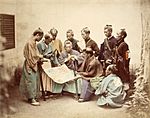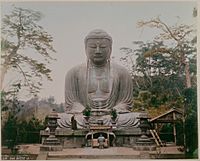Kamakura period facts for kids
 |
|---|
|
The Kamakura period (called Kamakura jidai in Japanese) was an important time in Japanese history. It lasted from 1185 to 1333. This period is named after the city of Kamakura. This city was the main center of power for the Kamakura shogunate.
The Kamakura shogunate was a military government led by a powerful general called a shogun. Minamoto no Yoritomo officially started this government in 1192.
The Kamakura period ended in 1333. The shogunate was destroyed, and the emperor, Emperor Go-Daigo, took back control of Japan.
Contents
New Ideas in Buddhism
During the Kamakura period, Buddhism became very popular. Many monks started new Buddhist groups, called sects. These new sects made Buddhism easier for everyone to understand and practice.
Some of the important monks and the sects they founded include:
- Hōnen, who started the Jōdo shū sect.
- Shinran, a student of Hōnen, who founded Jōdo Shinshū.
- Ippen, who began the Ji sect.
- Dōgen, who founded the Sōtō school of Zen Buddhism.
- Eisai, who started the Rinzai school of Zen Buddhism.
- Nichiren, who founded a Buddhist sect named after him.
Older Buddhist groups like Shingon and Tendai also continued to be important.
Important Events of the Kamakura Period
Here are some key events that happened during the Kamakura period:
- 1185: The Taira clan (also known as the Heike) were defeated at sea by Minamoto Yoshitsune. This was a big victory for the Minamoto clan.
- 1191: Eisai brought Zen Buddhism to Japan.
- 1192: Minamoto no Yoritomo was officially named the shogun. This marked the start of the Kamakura shogunate.
- 1207: Hōnen and his followers were sent away from the capital.
- 1221: The Jōkyū War happened. Emperor Go-Toba tried to take power back from the Kamakura shogunate. But his attempt was not successful.
- 1252: The famous Great Buddha statue of Kamakura was placed at Kōtoku-in temple.
- November 19, 1274: Kublai Khan sent a large fleet and army to invade Japan. This event is known as the Battle of Bun'ei.
- 1281: Another invasion attempt by the Mongols happened. This was called the Battle of Kōan.
- 1293: A terrible earthquake and tsunami hit Sagami Bay and Kamakura. It killed many people.
- 1333: Nitta Yoshisada led an attack that destroyed the Kamakura shogunate. This was called the Siege of Kamakura.
Gallery
Related pages
- Metropolitan Museum of Art, Kamakura and Nanbokucho Periods (1185–1392)
- British Museum, Kamakura period (AD 1185-1333)
- Japan-guide.com, Kamakura Period (1192 - 1333)
Images for kids
-
A famous Japanese wooden kongorikishi statue of Tōdai-ji, Nara. It was made by Busshi Unkei in 1203.
-
Head of a Guardian, 13th century. Hinoki wood with lacquer on cloth, pigment, rock crystal, metal. Before entering most Japanese Buddhist temples, visitors must pass large and imposing sculptures of ferocious guardian figures whose role is to protect the premises from the enemies of the religion. The aggressive stances and exaggerated facial features of these figures stand in sharp contrast to the calm demeanor of the Buddha enshrined inside. Brooklyn Museum
-
Japanese samurai boarding Mongol ships in 1281
See also
 In Spanish: Período Kamakura para niños
In Spanish: Período Kamakura para niños






